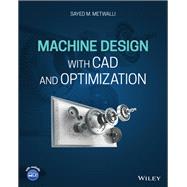A guide to the new CAD and optimization tools and skills to generate real design synthesis of machine elements and systems
Machine Design with CAD and Optimization offers the basic tools to design or synthesize machine elements and assembly of prospective elements in systems or products. It contains the necessary knowledge base, computer aided design, and optimization tools to define appropriate geometry and material selection of machine elements. A comprehensive text for each element includes: a chart, excel sheet, a MATLAB® program, or an interactive program to calculate the element geometry to guide in the selection of the appropriate material.
The book contains an introduction to machine design and includes several design factors for consideration. It also offers information on the traditional rigorous design of machine elements. In addition, the author reviews the real design synthesis approach and offers material about stresses and material failure due to applied loading during intended performance. This comprehensive resource also contains an introduction to computer aided design and optimization. This important book:
- Provides the tools to perform a new direct design synthesis rather than design by a process of repeated analysis
- Contains a guide to knowledge-based design using CAD tools, software, and optimum component design for the new direct design synthesis of machine elements
- Allows for the initial suitable design synthesis in a very short time
- Delivers information on the utility of CAD and Optimization
- Accompanied by an online companion site including presentation files
Written for students of engineering design, mechanical engineering, and automotive design. Machine Design with CAD and Optimization contains the new CAD and Optimization tools and defines the skills needed to generate real design synthesis of machine elements and systems on solid ground for better products and systems.








